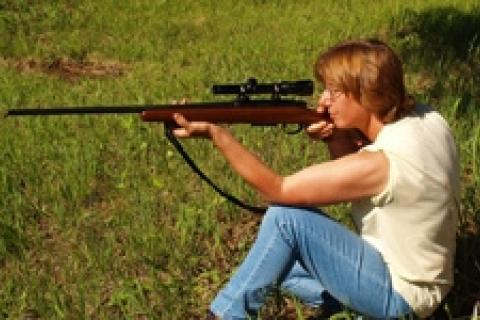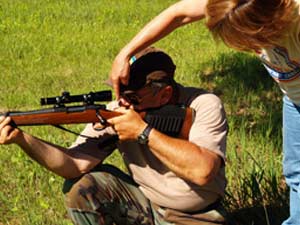
Dry firing is the act of picking up and cocking an unloaded firearm and going through the motions of a shot, including pulling the trigger. It's really as simple as that.
But it's also far more complex. When done correctly, it is one of the most important and convenient ways to improve marksmanship and gain familiarity with your centerfire rifle.
 |
| Linda Miller demonstrates dry firing practice from a proper sitting position. Photo by Jerry Grozelle |
I spoke with Keith Cunningham, the owner of the Milcun Marksmanship Complex near Minden, Ontario about the importance of the practice.
What Keith Cunningham doesn't know about marksmanship is hardly worth knowing. A career officer of more than 25 years in the Canadian Forces and US Army, his practical experience includes a combat tour in Vietnam and counter-sniper operations in Cyprus. He's the author of several technical books on various aspects of shooting and has been a marksmanship instructor at the Canadian Forces Infantry School and for several police forces. He and his wife Linda Miller, whose shooting credentials are equally impressive, still teach courses for these professionals at their shooting complex.
Moreover, he's an internationally certified shooting coach who has led teams to national and international excellence. A highly skilled gunsmith, he also builds long-range practical rifles used by international competitors around the world.
As if that's not enough, Cunningham is an internationally renowned rifle and pistol competitor, who has won honors at Bisley, the World Long Range Championships, and the Commonwealth Games. He was the 2008 and 2009 Canadian national service rifle and three-gun (pistol, service rifle, sniper rifle) champion.
That's just the short resume.
So what does an expert marksman with this much experience and training knowledge say about dry fire exercises?
"Dry firing is the primary method of teaching people how to fire the perfect shot," says Cunningham. "If I had just one hour to teach a person how to improve their shooting, I'd go right to dry fire exercises."
I think that's clear enough. Now let's talk about the nuances.
Gun Safety first
 |
| Linda Miller has Keith demonstrate proper fit with her "Rule of Thumb." Photo by Jerry Grozelle |
As in all firearms handling, safety is supreme. Remember, when doing these exercises, you're pulling the trigger. That means you must ensure that your firearm is unloaded and always pointed in a safe direction.
It's best to practice dry firing alone or with a partner who is equally committed to learning how to make the perfect shot. It should be done in a time and place where there will be no interruptions. This exercise requires your full concentration and lots of repetition before it becomes ingrained. Distractions are counterproductive.
The Perfect Shot With Your Firearm
Making the perfect shot is what this is all about, and dry firing is intended to make the mechanics of this process second nature.
Cunningham says every shot should begin with a comfortable, solid shooting position. "People have a tendency to tense up at the shot — that's wrong. You should have a relaxed upper body — the more relaxed the better."
Once you are in that place, Cunningham says your total focus should be on the sight picture. "You need to concentrate fully on this and keep your sight as close to the target as your wobble will allow."
"While doing that," he says, "you should begin a slow, subconscious trigger squeeze. It should be steady and straight to the rear. The shot will go off in the next couple of seconds but it should come as a surprise."
Ideally, he says, this should happen when you are completely focused on the sight picture. This surprise factor is important, says Cunningham, because, before you can react, the shot is already out. "That's why it's critical to be relaxed rather than tense."
Cunningham favors using "as much finger as you can" on the trigger of a typical hunting rifle (one whose trigger pull weight is between two and five pounds). Generally, he says, that's to the first joint for most people. "It's all about leverage and control," he says.
During the shot he favors the method of breathing that's suited to the situation. For instance, when waiting calmly in a stand, he begins the trigger pull during a natural respiratory pause.
If you have exerted yourself, however, say by climbing a ridge, Cunningham says it's better to shoot after taking in a gulp of air. "A good gulp of air helps you calm your breathing and settle on a sight picture."
He also recommends Four Square Breathing. This technique will help calm you down when nervousness or buck fever take hold. Basically, you take a deep breath for a count of four, hold it for the same count, release it on a count of four and then do nothing for a count of four.
"I have used this technique between shots at important international competitions when the pressure is on. It works well," says Cunningham. "It fills your lungs up with air and allows you to calm down."
How Much Dry Firing is Enough?
 |
| This is a good trigger finger position. Note the leverage gained by placing more finger on the trigger. Photo by Jerry Grozelle |
So how much dry fire practice is enough? Cunningham says you can practice for as long as you can do it correctly. "If you start to get sloppy, distracted or tired, quit." Quality, not quantity, is key.
Dry fire practice is an ideal way to maintain or improve shooting form and work out issues that detract from accuracy. For instance, repetitive dry fire practice is an effective way to reduce flinching. It also builds confidence, which is critical to excellence in shooting.
The Firing Transition and the Process
Of course, perfecting your dry firing techniques means nothing if you revert to the old ways on the range. Cunningham says that's what sometimes happens. "There are times when, for whatever reason, a shooter will forget all those good habits in the transition to live firing."
The remedy, he says, is to slow down and concentrate on the shot process. "A lot of shooters worry too much about the end result — where the shot went. A better way is to focus on the process (just as you do during dry fire practice). If you do this correctly, the rifle will do its part.
Part & Parcel
It should go without saying that to make the most of this and become the best shot you can be, you need a rifle that fits and is inherently accurate. Add to that the right ammunition and a good sighting system and trigger.
Miller says she determines proper rifle fit with her "Linda's rule of thumb." To use this method, you assume a proper prone position and then can raise your thumb from the hand that's on the pistol grip. If it touches your nose, the rifle fit is good.
When it comes to calibers, Cunningham believes that most hunters are over gunned for deer. "I think people need to reconsider the bigger is better school of thought. Shot placement is everything and most people have a harder time being accurate with larger calibers. Flinching can become an issue..."
If you can handle a bigger caliber that's fine, he says; but most shooters do better with smaller calibers such as the .243 or .260, however.
Dry firing is a great way to gain familiarity with your rifle, its sight and trigger while maintaining or improving your own shooting technique. It's inexpensive, convenient, very effective and highly endorsed by professional shooters in the police and military. Few training methods pay such incredible dividends in the field. And you can't hurt a centerfire rifle by doing this.
Give it a try. You'll notice a difference next time you visit the range.
- 7913 views

